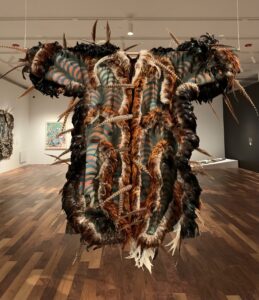Recently opened at the New Museum, “Faith Ringgold: American People” presents more than 120 works from the trailblazing artist’s sixty-year career. Born in Harlem and actively creating art before, after, and in response to the civil rights era, Ringgold has brought a wide range of American experiences to light, grappling with race and gender and refusing to shy away from issues of social justice. Best known for her story quilts, Ringgold’s choice of subject matter, media, and her identity as a Black woman challenged mainstream tastes and professional acceptance throughout much of her career. This retrospective is the most comprehensive survey of her work in nearly 40 years.
Exhibition review in The New York Times
If you want to catch the heat of the lava flow that was United States racial politics in the 1960s, the second floor of the New Museum in Manhattan is a good place to go. There you’ll find the earliest work in “Faith Ringgold: American People,” the first local retrospective of the Harlem-born artist in almost 40 years.
Now 91, Ringgold was already a committed painter when the Black Power movement erupted. And she had a personal investment in the questions it raised: not just how to survive as a Black person in a racist white world, but how, as a woman, to thrive in any world at all.
As an artist of ambition, she seems to have made strategic decisions for forward movement. One was to be constantly producing, no matter what. Another was to seek out support within a Black matriarchy of family and friends. A third decision — the tough one — was to forge a career path of maximum resistance. To this end, she pursued figure painting, worked with fabric art and focused on narrative content at a time when the mainstream art market wanted little to do with any of these.
This retrospective, which fills three floors of the New Museum, combines figures, craft techniques and storytelling in inventive combinations. And it makes clear that what consigned Ringgold to an outlier track half a century ago puts her front and center now.







